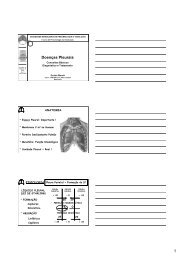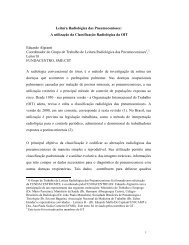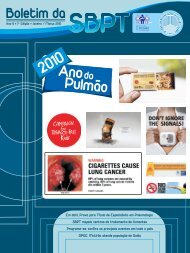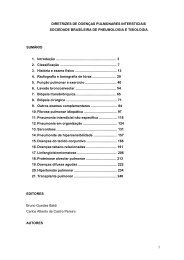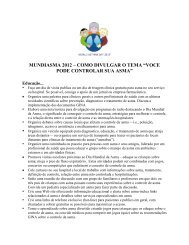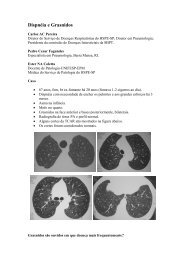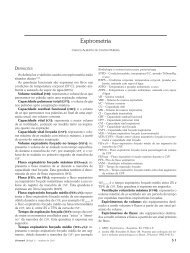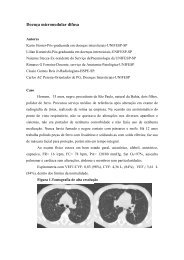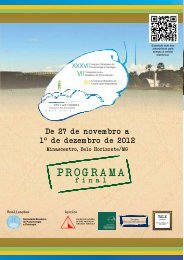Diretrizes da Sociedade Brasileira de Pneumologia e Tisiologia ...
Diretrizes da Sociedade Brasileira de Pneumologia e Tisiologia ...
Diretrizes da Sociedade Brasileira de Pneumologia e Tisiologia ...
Create successful ePaper yourself
Turn your PDF publications into a flip-book with our unique Google optimized e-Paper software.
<strong>Diretrizes</strong> <strong>da</strong> Socie<strong>da</strong><strong>de</strong> <strong>Brasileira</strong> <strong>de</strong> <strong>Pneumologia</strong> e <strong>Tisiologia</strong> para o Manejo <strong>da</strong> Asma - 2012<br />
por sua vez, têm mais dificul<strong>da</strong><strong>de</strong> <strong>de</strong> a<strong>de</strong>rir ao<br />
tratamento e manter o controle <strong>da</strong> asma. (100) A<br />
baixa percepção dos sintomas, a não a<strong>de</strong>são ao<br />
tratamento e a falta <strong>de</strong> controle <strong>da</strong> doença estão<br />
mais presentes nos que têm predominantemente<br />
<strong>de</strong>pressão. Asmáticos graves têm mais distúrbios<br />
emocionais do que aqueles com asma leve<br />
ou mo<strong>de</strong>ra<strong>da</strong>. (101-103) Recomen<strong>da</strong>-se que, em<br />
pacientes com asma <strong>de</strong> difícil controle, esses<br />
fatores sejam a<strong>de</strong>qua<strong>da</strong>mente valorizados.<br />
Aspergilose broncopulmonar alérgica<br />
A aspergilose broncopulmonar alérgica<br />
<strong>de</strong>ve ser investiga<strong>da</strong> em pacientes com asma<br />
cortico<strong>de</strong>pen<strong>de</strong>nte e com bronquiectasias<br />
centrais ou infiltrados pulmonares, naqueles<br />
com teste cutâneo positivo para Aspergillus sp.<br />
ou naqueles com dosagem <strong>de</strong> IgE total superior a<br />
1.000 U/L e IgE ou IgG contra Aspergillus sp. no<br />
sangue. (104) Aproxima<strong>da</strong>mente 25% dos asmáticos<br />
reagem positivamente ao teste cutâneo imediato<br />
contra Aspergillus sp., indicando sensibilização,<br />
mas não necessariamente a doença. (105)<br />
O tratamento <strong>da</strong> aspergilose broncopulmonar<br />
alérgica é guiado e monitorado através do nível<br />
<strong>de</strong> controle <strong>da</strong> asma, infiltrados radiológicos,<br />
função pulmonar e níveis <strong>de</strong> IgE. Recomen<strong>da</strong>-se<br />
iniciar o tratamento com 0,50-0,75 mg/kg/dia<br />
<strong>de</strong> prednisona, com redução gradual <strong>da</strong> dose a<br />
ca<strong>da</strong> 6 semanas. (106) O tempo total <strong>de</strong> tratamento<br />
é <strong>de</strong> 6-12 meses. Uma revisão sistemática<br />
sobre o uso <strong>de</strong> itraconazol (200 mg 12/12 h)<br />
mostrou uma que<strong>da</strong> <strong>de</strong> pelo menos 25% nos<br />
níveis <strong>de</strong> IgE, com melhora clínica e redução nas<br />
exacerbações, mas sem repercussões na função<br />
pulmonar. (106)<br />
Medicamentos e instabili<strong>da</strong><strong>de</strong> <strong>da</strong> asma<br />
Até 28% dos adultos com asma, mas<br />
raramente crianças, sofrem <strong>de</strong> exacerbações em<br />
resposta à aspirina e a outros anti-inflamatórios<br />
não esteroi<strong>de</strong>s. (107) Outros medicamentos<br />
também po<strong>de</strong>m causar broncoespasmo,<br />
como, por exemplo, os beta-bloqueadores. (108)<br />
Recomen<strong>da</strong>-se evitar completamente as drogas<br />
que causam os sintomas.<br />
Referências<br />
1. Global Initiative for Asthma – GINA [homepage on the<br />
Internet]. Bethes<strong>da</strong>: Global Initiative for Asthma. [cited<br />
2011 Apr 1] Global Strategy for Asthma Management<br />
and Prevention, 2010. [Adobe Acrobat document,<br />
S19<br />
119p.] Available from: http://www.ginasthma.org/pdf/<br />
GINA_Report_2010.pdf<br />
2. Socie<strong>da</strong><strong>de</strong> <strong>Brasileira</strong> <strong>de</strong> <strong>Pneumologia</strong> e <strong>Tisiologia</strong>.<br />
Socie<strong>da</strong><strong>de</strong> <strong>Brasileira</strong> <strong>de</strong> Pediatria. Socie<strong>da</strong><strong>de</strong> <strong>Brasileira</strong><br />
<strong>de</strong> Alergia e Imunopatologia. I Consenso Brasileiro<br />
<strong>de</strong> Educação em Asma. J Pneumol. 1996;22(Suppl<br />
1):1-24.<br />
3. <strong>de</strong> Oliveira MA, Bruno VF, Ballini LS, BritoJardim<br />
JR, Fernan<strong>de</strong>s AL. Evaluation of an educational<br />
program for asthma control in adults. J Asthma.<br />
1997;34(5):395-403.<br />
4. Cabral AL, Carvalho WA, Chinen M, Barbiroto RM,<br />
Boueri FM, Martins MA. Are International Asthma<br />
Gui<strong>de</strong>lines effective for low-income Brazilian children<br />
with asthma? Eur Respir J. 1998;12(1):35-40.<br />
5. <strong>de</strong> Oliveira MA, Faresin SM, Bruno VF, <strong>de</strong> Bittencourt<br />
AR, Fernan<strong>de</strong>s AL. Evaluation of an educational<br />
programme for socially <strong>de</strong>prived asthma patients. Eur<br />
Respir J. 1999;14(4):908-14.<br />
6. Cowie RL, Un<strong>de</strong>rwood MF, Mack S. The impact of<br />
asthma management gui<strong>de</strong>line dissemination on the<br />
control of asthma in the community. Can Respir J.<br />
2001;8 Suppl A:41A-5A.<br />
7. Peterson MW, Strommer-Pace L, Dayton C. Asthma<br />
patient education: current utilization in pulmonary<br />
training programs. J Asthma. 2001;38(3):261-7.<br />
8. Gibson PG, Powell H. Written action plans for asthma:<br />
an evi<strong>de</strong>nce-based review of the key components.<br />
Thorax. 2004;59(2):94-9.<br />
9. Coutts JA, Gibson NA, Paton JY. Measuring compliance<br />
with inhaled medication in asthma. Arch Dis Child.<br />
1992;67(3):332-3.<br />
10. Vieira JE, Cukier A, Stelmach R, Kasahara DI, Gannam<br />
S, Warth M. Comparison of knowledge on asthma:<br />
doctors completing internal medicine resi<strong>de</strong>ncy and<br />
doctors completing medical school. Sao Paulo Med J.<br />
2001;119(3):101-4.<br />
11. Mannino DM, Homa DM, Redd SC. Involuntary<br />
smoking and asthma severity in children: <strong>da</strong>ta from<br />
the Third National Health and Nutrition Examination<br />
Survey. Chest. 2002;122(2):409-15.<br />
12. Fernan<strong>de</strong>s AL, Stelmach R, Algranti E. Occupational<br />
asthma [Article in Portuguese]. J Bras Pneumol.<br />
2006;32 Suppl 2:S27-34.<br />
13. Custovic A, Wijk RG. The effectiveness of<br />
measures to change the indoor environment in<br />
the treatment of allergic rhinitis and asthma: ARIA<br />
up<strong>da</strong>te (in collaboration with GA(2)LEN). Allergy.<br />
2005;60(9):1112-5.<br />
14. Gøtzsche PC, Johansen HK, Schmidt LM, Burr ML.<br />
House dust mite control measures for asthma. Cochrane<br />
Database Syst Rev. 2004;(4):CD001187.<br />
15. Morgan WJ, Crain EF, Gruchalla RS, O’Connor GT,<br />
Kattan M, Evans R 3rd, et al. Results of a home-based<br />
environmental intervention among urban children with<br />
asthma. N Engl J Med. 2004;351(11):1068-80.<br />
16. Wood RA, Johnson EF, Van Natta ML, Chen PH,<br />
Eggleston PA. A placebo-controlled trial of a HEPA air<br />
cleaner in the treatment of cat allergy. Am J Respir Crit<br />
Care Med. 1998;158(1):115-20.<br />
17. Woodcock A, Forster L, Matthews E, Martin J, Letley L,<br />
Vickers M, et al. Control of exposure to mite allergen<br />
and allergen-impermeable bed covers for adults with<br />
asthma. N Engl J Med. 2003;349(3):225-36.<br />
J Bras Pneumol. 2012;38(supl.1):S1-S46



